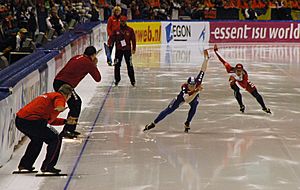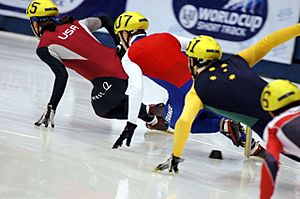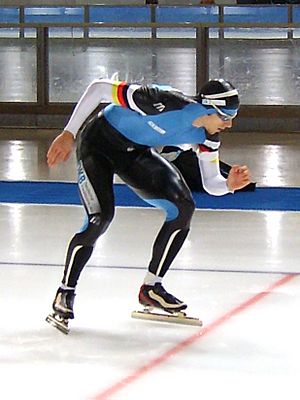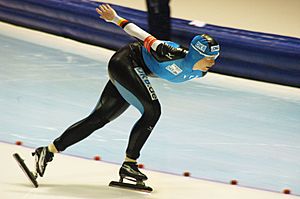Speed skating facts for kids
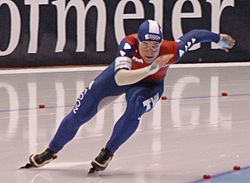
Paulien van Deutekom, Thialf, 2007
|
|
| Highest governing body | International Skating Union |
|---|---|
| Characteristics | |
| Mixed-sex | Yes |
| Presence | |
| Olympic | 1924 |
Speed skating is a fun and fast sport where athletes race each other on skates over ice. It's a type of ice skating where the goal is to travel a certain distance as quickly as possible.
There are different kinds of speed skating:
- Long track speed skating
- Short track speed skating
- Marathon speed skating
When you watch the Olympic Games, "speed skating" usually means long track. "Short track" is a separate event. The main group that manages both sports, the International Skating Union (ISU), also calls them "speed skating" (for long track) and "short track skating."
Speed skating has been around for a long time. An international group for the sport was started in 1892. This was the first time any winter sport had its own international group! Speed skating is very popular in countries like the Netherlands, Norway, and South Korea. You can also find top skating rinks in places like Canada, the United States, Germany, Italy, Japan, Russia, Kazakhstan, China, Belarus, and Poland. Skaters from these countries compete in the Speed Skating World Cup series, which includes events in the famous Thialf ice hall in Heerenveen, Netherlands.
Contents
Understanding Speed Skating
Speed skating happens on special ice tracks. The type of track depends on the kind of speed skating.
Long Track Speed Skating
Long track speed skating uses a big oval track, usually 400 meters long. Sometimes, tracks of 200, 250, or 333 meters are used. This is one of the two types of speed skating you see at the Olympics. It has a very long history. The rules from the International Skating Union allow for small differences in the size and curves of these tracks.
Short Track Speed Skating
Short track speed skating uses a smaller rink. It's usually the same size as an ice hockey rink, with an oval track that is 111.12 meters long. The races are shorter than in long track. For example, the longest individual Olympic race is 1500 meters. Team relay races are 3000 meters for women and 5000 meters for men.
Short track events often use a knockout style. Skaters compete in small groups, and only the top two from each race move on to the next round. This continues until the final race, where medals are given out. It's common for skaters to be disqualified or to fall during these races.
Mass Start Races
Some races have many skaters starting at the same time. These are called mass-start races. There are different types, like elimination races where skaters are removed at certain points. There are also simple distance races and endurance races that have time limits.
Fair Play Rules
Speed skating has rules to prevent skaters from unfairly blocking or bothering opponents. These rules can be different for each type of skating.
In long track, if a skater gets in the way of their partner, they might be penalized. Skaters can switch lanes on the final curve if they can't hold their lane, as long as they don't interfere with the other skater. In mass-start races, skaters are usually allowed some physical contact.
Team Races
Team races are also part of speed skating. In long track, the main team race at the highest level is the Team pursuit. In this race, two teams of three or four skaters race at once. They stay in the inner lane and start on opposite sides of the rink. The clock stops when the third skater on a team crosses the finish line.
Relay races are also held in short track and inline skating. In these races, teammates can tag each other at any time, except sometimes during the last few laps.
Track Shapes and Sizes
Most speed skating races are on oval tracks.
- Short track uses a 111.12-meter oval.
- Long track uses a 400-meter oval.
- Inline skating tracks can be 125 to 400 meters. Some banked tracks are 250 meters long.
Inline skating can also happen on closed road courses (400 to 1,000 meters) or open-road courses. In open-road races, the start and finish lines are in different places. This is also true for outdoor marathon races.
In the Netherlands, marathon races sometimes happen on natural ice, like frozen canals, lakes, and rivers. They can also be held on 400-meter artificial tracks, where skaters might go around 100 times!
History of Speed Skating
Speed skating started over a thousand years ago in places like Scandinavia, Northern Europe, and the Netherlands. People would attach bones to their shoes to travel on frozen water. However, ice skating was mostly for fun and sport, not for daily travel. Winters in the Netherlands, for example, were not cold enough for ice to be a reliable way to get around.
One of the earliest descriptions of ice skating as a sport comes from London in 1194. Later, in Norway, King Eystein Magnusson (who became King Eystein I) even bragged about his ice skating skills!
Skating wasn't just in the Netherlands and Scandinavia. In 1592, a person from Scotland designed a skate with an iron blade. These iron blades helped skating, especially speed skating, become more popular.
- In 1642, the first official skating club, The Skating Club Of Edinburgh, was formed.
- In 1763, the first official speed skating race took place in Wisbech, England. The prize was 70 guineas!
- In the Netherlands, people started touring the waterways connecting 11 cities in Friesland. This challenge eventually led to the famous Elfstedentocht race.
By 1851, people in North America loved the sport, and they later developed the all-steel skate blade. The Netherlands became important again in 1889 when they organized the first world championships. The International Skating Union (ISU) was also founded in the Netherlands in 1892. By the early 1900s, speed skating was a major popular sport.
ISU and Early Competitions

Organized ice skating races really grew in the 1800s. Clubs in Norway held competitions starting in 1863, with some races in Christiania attracting huge crowds. In 1884, a Norwegian skater named Axel Paulsen was called the "Amateur Champion Skater of the World" after winning races in the United States.
Five years later, a sports club in Amsterdam held a "world championship" ice skating event. Skaters from Russia, the United States, the United Kingdom, and the Netherlands took part. The Internationale Eislauf Vereinigung (now the International Skating Union) was created in 1892. This was the first international group for any winter sport!
The ISU set standard rules for long track speed skating:
- The track length was set at 400 meters.
- Standard race distances for world championships became 500m, 1500m, 5000m, and 10,000m.
- Skaters started in pairs, each in their own lane. They switched lanes every lap to make sure both skated the same distance. This is what we now call long track speed skating.
Early competitions were only for amateur skaters. If a skater was found to be a professional, they were disqualified. For example, Peter Sinnerud lost his world title in 1904 because he was a professional.
Long track world records started being recorded in 1891. They improved very quickly at first. Jaap Eden broke the 5000-meter world record by half a minute in 1894. That record lasted for 17 years! It took another 50 years to lower it by another half minute.
The Elfstedentocht Race
The Elfstedentocht is a famous marathon speed skating race in the Netherlands. It was first held as a competition in 1909. This race only happens when the natural ice on the course is thick and safe enough. This means it's held at different times, not every year.
Before artificial ice rinks became common in 1962, national championships in the Netherlands were held on natural ice. Since artificial ice became widely available, Dutch speed skaters have become some of the best in the world in both long track and marathon skating.
When the Elfstedentocht can't be held in the Netherlands, "Alternative Elfstedentocht" races are sometimes held in other countries like Austria, Finland, or Canada. Top marathon skaters and thousands of amateur skaters travel from the Netherlands to these races.
Speed Skating at the Olympics
In 1914, it was decided that ice speed skating would be part of the 1916 Olympics. However, World War I stopped those plans. Speed skating finally became an Olympic sport at the first Winter Sports Week in Chamonix in 1924. This event was later officially recognized as the first Winter Olympics.
- Charles Jewtraw from the United States won the first Olympic gold medal in speed skating.
- Finland won the other four gold medals in 1924. Clas Thunberg won the 1,500 meters, 5,000 meters, and the allround title. This was the only time an allround Olympic gold medal was given in speed skating.
- Speed skating is still an important sport in today's Olympics.
Between the World Wars, Norwegian and Finnish skaters won all the gold medals at world championships. At the 1932 Winter Olympics, the ISU allowed pack-style (mass start) races. Americans won all four gold medals that year. However, many skaters and leaders from other countries protested this style of racing.
The ISU later brought back mass-start races with the short track speed skating branch in 1967. International short track competitions started in 1976, and short track became an Olympic sport in 1992.
New Technologies in Speed Skating
Artificial ice rinks were first used for long track competitions at the 1960 Winter Olympics. The 1956 Olympics on Lake Misurina were the last to use natural ice. Also in 1960, women competed in Winter Olympic speed skating for the first time.
Skaters also started using more aerodynamic suits. These special suits help skaters move faster by reducing air resistance. Franz Krienbühl, a Swiss skater, was a pioneer in developing these suits. Now, national teams design their own body suits. Short track skaters also use these suits, but they wear helmets instead of hoods attached to the suit, because falls are more common in mass-start races.
Another big invention was the clap skate. This skate allows the heel of the boot to lift off the blade during each stride. This helps skaters push off the ice more powerfully. These improvements – better suits, indoor rinks, and clap skates – have helped skaters break many long track world records. For example, from 1971 to 2009, the average speed for the men's 1500 meters increased from 45 to 52 km/h. Other distances have seen similar speed increases.
Professional Speed Skating
After the 1972 season, some European long track skaters started a professional league. However, this league closed in 1974 for money reasons. The ISU later started its own World Cup circuit with prize money. In the 1990s, full-time professional teams grew in the Netherlands. This led to Dutch skaters dominating the men's side of the sport.
In North America, roller skating also became a competitive sport. Roller-skating races were professional early on. Many world champions in inline speed skating, like Derek Parra and Chad Hedrick, later switched to ice skating to win Olympic medals.
Ice speed skating was also professional in North America. Oscar Mathisen, a five-time ISU world champion, became a professional in 1916. He raced in America, where he competed against top American skaters like Bobby McLean. Chicago was a big center for ice speed skating in America.
Short Track Becomes Olympic
In 1992, short track speed skating became an official Olympic sport. This type of speed skating was not very popular in traditional long track countries like Norway, the Netherlands, and the former Soviet Union at first. However, short track has grown faster than long track. This is mainly because short track can be done on a regular ice hockey rink, which is much more common than a long track oval.
Rules of Speed Skating
Speed skating has specific rules for each type of race to ensure fairness.
Short Track Rules
- Races are run counter-clockwise on a 111-meter track.
- Short track races almost always use a mass start, with two to six skaters racing at once.
- Skaters can be disqualified for:
* False starts: Moving before the starting gun fires. * Impeding: Cutting in front of another skater and causing them to slow down or fall. * Cutting inside the track: When a skater's skates go inside the blocks that mark the track.
- If disqualified, the skater gets last place in their race or final.
Long Track Rules
- Races are run counter-clockwise on a 400-meter oval.
- In individual races, only two skaters race at a time.
- Skaters must change lanes every lap. The skater moving from the outside lane to the inside lane has the right-of-way.
- Skaters can be disqualified for false starts, impeding, or cutting inside the track.
- If a skater misses their race or falls, they usually have the option to race their distance again.
- There are no heats or finals in long track; all rankings are based on the fastest times.
The start of a long track race has three steps: 1. The referee tells athletes to "Go to the start." 2. The referee tells them to get "Ready" and waits for them to stop moving. 3. The referee waits for a random time (1 to 1.5 seconds) and then fires the starting shot.
Team Pursuit Rules
In the team pursuit, two teams of three or four skaters race at once. Both teams stay in the inner lane. They start on opposite sides of the rink. If a team has four skaters, one skater is allowed to drop off and stop racing. The clock stops when the third skater on the team crosses the finish line.
Speed Skating Equipment
Skaters use special equipment to help them go fast and stay safe.
Speed Skates
Speed skates look very different from hockey or figure skates.
- They are cut off at the ankle, more like a shoe than a boot. This allows the ankle to bend more.
- The blades are 30 to 45 cm long, depending on the skater's age and height.
There are two main types of speed skates:
- Short track blades: These are fixed to the boot in two places: at the heel and behind the ball of the foot.
- Long track skates (Clap skates): These attach firmly to the boot only at the front. The heel of the boot lifts off the blade with each stride, thanks to a spring mechanism at the front.
Speed skates are sharpened by hand using a special tool called a jig to hold them steady.
Short Track Gear
All short track skaters must wear:
- Speed skates
- A tight-fitting spandex suit (often called a "skin suit")
- A protective helmet
- Special cut-proof skating gloves
- Knee pads and shin pads (worn inside the suit)
- A neck guard (bib style)
- Ankle protection
- Protective eyewear is a must.
Many skaters wear smooth ceramic or carbon fiber tips on their left hand glove. This helps them glide smoothly when they touch the ice on corners. Skaters who race at a national level must wear a cut-proof kevlar suit. This protects them from being cut by another skater's blade if there's a fall.
Long Track Gear
Long track skaters wear similar equipment to short track racers, but with some differences:
- They must wear speed skates and a spandex suit.
- A helmet, shin pads, knee pads, and neck guard are not required.
- Protective eyewear is not mandatory.
- The suit does not need to be made of kevlar.
- Long track skaters wear a hood that is built into their suit.
Images for kids
See also
 In Spanish: Patinaje de velocidad sobre hielo para niños
In Spanish: Patinaje de velocidad sobre hielo para niños


